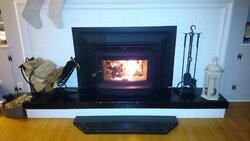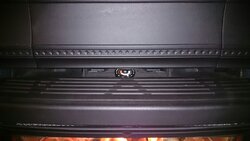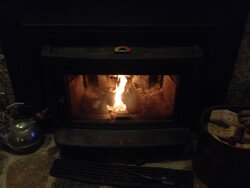Hello All,
I am new to the forum & have been reading some other posts on the Hearthstone Clydesdale wood burning insert about measuring temperature & over-firing, but couldn't find an exact answer/experience with my questions so I figured I would try a new post out.
I live in CT & purchased the Hearthstone Clydesdale wood burning insert last year around the same time so I am on my second season. Up to this point and including my first year I have fears of over-firing the stove. I know this insert can put out a lot of heat & from what I've read it does have the possibility of getting way too hot. I would like to feel safe with my burning where I can get a good overnight burn, but at this point I find myself only putting 1 to 2 pieces of wood in at a time to just try and keep it from over heating.
I purchased an Inferno stove top magnetic gage last year and have been using that to tell the temperature of the stove top. I did some testing of different positions to try and find the hottest spot, which I found to be behind the top grill in the center at the point where the stove steps up. It appears to be the hottest part of the stove top, but reading the manual it suggests having the gage be on the "top front of the insert (firebox body under grill)" & not to exceed 600 degrees F. I tried to put the Inferno gage below the grate, but it is too thick and the grate won't sit properly on the stove top. I thought of just removing the grate completely and running without it, but didn't like the idea of not using as I am sure there is a specific design feature for it.
I recently purchase an IR thermometer to better understand how the insert is acting in different areas more instantly than the Inferno. I've found the the stove top area near the front as the manual says is about 100 - 150 degrees F lower than where I am currently measuring the stove top. Last season I started with loading the firebox as I believe the insert should be able to handle the design size of the firebox, but found that the back part of the stove top I am reading can easily get up to 600 - 700 degrees F. As soon as I saw this a few times I stopped loading the box & only used small loads and shorter intervals. This was even with the damper closed almost all the way. There was a good amount of secondary burning going on, which I liked because it meant it was burning efficiently but the temperatures just seemed way too high.
This is where my issue with overnight burns come into play. I want to have the fire going with a full or 3/4 full firebox, but just don't feel comfortable with the temperatures I am seeing at the current measuring location. My question is, are other owners of the Clydesdale seeing similar temperature differences between the stove top near the front of the insert below the grate vs. the back stepped portion of the stove top where I am currently using as my do not exceed 600 F limit?
Apologies for the long set of information, but wanted to try and get the best description I could the first time.
I've also read about the vibrating sheet metal fan support, which I too have had issues with. If it get the stove in those higher ranges 575 - 600 degrees F, I find that the sheet metal piece starts to vibrate, which then becomes impossible to stop. I tried to contact my vendor to come out and take a look at it, but haven't been having much luck getting them to set up a time to come out. I've read about the Hearthstone fix to the issue and would like to understand it better, but can't seem to get them to give me any attention.
Thanks in advance for everyone's help.
Also, I've attached a few pictures of my setup to help.


I am new to the forum & have been reading some other posts on the Hearthstone Clydesdale wood burning insert about measuring temperature & over-firing, but couldn't find an exact answer/experience with my questions so I figured I would try a new post out.
I live in CT & purchased the Hearthstone Clydesdale wood burning insert last year around the same time so I am on my second season. Up to this point and including my first year I have fears of over-firing the stove. I know this insert can put out a lot of heat & from what I've read it does have the possibility of getting way too hot. I would like to feel safe with my burning where I can get a good overnight burn, but at this point I find myself only putting 1 to 2 pieces of wood in at a time to just try and keep it from over heating.
I purchased an Inferno stove top magnetic gage last year and have been using that to tell the temperature of the stove top. I did some testing of different positions to try and find the hottest spot, which I found to be behind the top grill in the center at the point where the stove steps up. It appears to be the hottest part of the stove top, but reading the manual it suggests having the gage be on the "top front of the insert (firebox body under grill)" & not to exceed 600 degrees F. I tried to put the Inferno gage below the grate, but it is too thick and the grate won't sit properly on the stove top. I thought of just removing the grate completely and running without it, but didn't like the idea of not using as I am sure there is a specific design feature for it.
I recently purchase an IR thermometer to better understand how the insert is acting in different areas more instantly than the Inferno. I've found the the stove top area near the front as the manual says is about 100 - 150 degrees F lower than where I am currently measuring the stove top. Last season I started with loading the firebox as I believe the insert should be able to handle the design size of the firebox, but found that the back part of the stove top I am reading can easily get up to 600 - 700 degrees F. As soon as I saw this a few times I stopped loading the box & only used small loads and shorter intervals. This was even with the damper closed almost all the way. There was a good amount of secondary burning going on, which I liked because it meant it was burning efficiently but the temperatures just seemed way too high.
This is where my issue with overnight burns come into play. I want to have the fire going with a full or 3/4 full firebox, but just don't feel comfortable with the temperatures I am seeing at the current measuring location. My question is, are other owners of the Clydesdale seeing similar temperature differences between the stove top near the front of the insert below the grate vs. the back stepped portion of the stove top where I am currently using as my do not exceed 600 F limit?
Apologies for the long set of information, but wanted to try and get the best description I could the first time.
I've also read about the vibrating sheet metal fan support, which I too have had issues with. If it get the stove in those higher ranges 575 - 600 degrees F, I find that the sheet metal piece starts to vibrate, which then becomes impossible to stop. I tried to contact my vendor to come out and take a look at it, but haven't been having much luck getting them to set up a time to come out. I've read about the Hearthstone fix to the issue and would like to understand it better, but can't seem to get them to give me any attention.
Thanks in advance for everyone's help.
Also, I've attached a few pictures of my setup to help.


Last edited by a moderator:



 so for the first week until I got a new set of blowers I ran it like a normal stove (my Clydesdale is out as far as allowed since I want as much radiant heat as possible) On the 3rd day I got cocky and packed it to the gills, she got up to almost 800, I freaked, opened the door and full throttled slowly and agonizingly down to 650. I had the grate off and the inferno stove thermometer in the center by the bolt.
so for the first week until I got a new set of blowers I ran it like a normal stove (my Clydesdale is out as far as allowed since I want as much radiant heat as possible) On the 3rd day I got cocky and packed it to the gills, she got up to almost 800, I freaked, opened the door and full throttled slowly and agonizingly down to 650. I had the grate off and the inferno stove thermometer in the center by the bolt. .....
.....